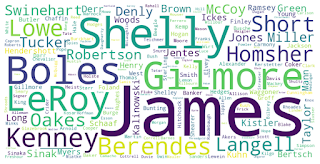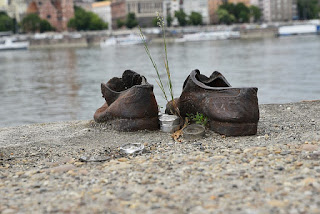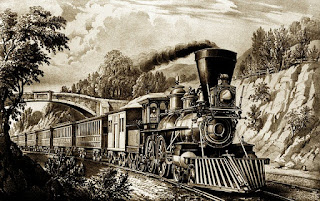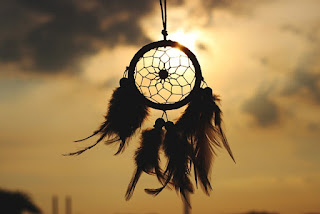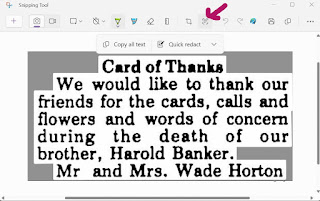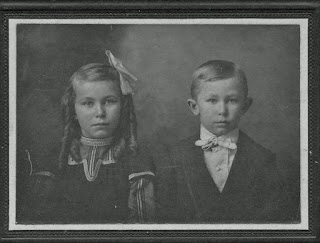Honoring those memorialized in family trees everywhere...and the ones yet to be discovered. Sharing inspiration, information & opinions for the journey finding family.
29 January 2024
Using ChatGPT Plus to Create a Surname Word Cloud
27 January 2024
Cyndi's List: Links for Everything Genealogy
Created in 1996 and boasting an impressive 250,000 unique visitors to the site each month, this well maintained and constantly updated site is something to behold. With 231 categories and 319,514 links (as of the date of this post), you're sure to be blown away by how comprehensive this compendium is. The user interface is simple and intuitive so you'll have no trouble locating what you need. If you're new to the site, start with the welcome on the home page and read the FAQs to learn more about how links are recorded and indexed. Then dive right into the alphabetical category listing or use the search box to find exactly what you're looking for. Don't take my word for how incredible this site is - search for yourself and prepare to be amazed!
It's hard to imagine the amount of hard work and dedication it takes to keep Cyndi's List up to date. The site is run by a single dedicated woman (Cyndi Ingle) who clearly has a passion for genealogy. The site is supported by affiliate links, advertisements, and donations. If you find the site helpful in your research, please consider using the affiliate links or making a donation to show your thanks. It's not often you'll find a gem such as this - make sure it's a staple in your genealogy toolbox.
24 January 2024
A Life Marked by Tragedy: Victor Michael Crow
To be clear, I love to write! I have absolutely no intention of letting AI write "for me"...but I might let it "help" me from time to time. For this post I asked ChatGPT if it could write a bio from the facts I supplied. I simply copied/pasted the facts from the person profile in my Ancestry tree. I was surprised at how well it did, but I wasn't totally happy with the first run through, so I asked ChatGPT to try again. There were parts of each result I liked, so I've merged them and made a few tweaks (including adding details from newspaper articles not included in the facts I provided and correcting a few dates where AI didn't have enough information to correct a newspaper date to the actual date incidents happened). Overall, I was really happy with how well it did! While AI can't replicate my sometimes dry and hopefully witty humor, for a piece like this, it was helpful. Without further ado...
Victor Michael Crow was born on August 30, 1918, in Lostine, Wallowa, Oregon. He was the son of Michael and Jennie Crow and entered into this world on a bright morning at 9:45 am. At the age of 23, he explored his talents as an actor. Following this, he pursued a college education, completing four years before January 30, 1942, showcasing his commitment to knowledge and personal growth. The winds of World War II swept him into the military, where he served in the Army Air Corps from January 30, 1942, to December 21, 1945. Starting as a Private, he rose to the rank of Sergeant, displaying dedication and valor.
Residing in Wallowa, Oregon, Victor's life took an unexpected turn on November 18, 1955. Tragedy struck Victor's family when his first wife, Mary Lou Greenwood, and daughter, Jeni Le Crow, passed away due to accidental exposure to freezing temperatures. This incident surely left an indescribable void in Victor's heart. Sadly, his young son found the bodies of his mother and sister. While the cause of death is not known for sure, the coroner believed Mary Lou may have broken her back or neck while climbing a haystack to get feed for livestock. He theorized Jeni Le may have followed her mother out to the barnyard and ended up in the freezing cold alone. As his mother had told him she would be out for the afternoon, 11 year old Philip was not worried when he arrived home from school and no one was home. He ended up going to bed. When he woke the next morning and there was still no one around, he went out to look for them and found the bodies. With his father away for work, he drove a tractor 2 miles to town to report the incident. I can't begin to imagine how their deaths affected both Victor and Philip.
In the midst of life's challenges, Victor found love again. On June 12, 1959, at the age of 40, he married Elda Mae Childers in Boise, Ada, Idaho. Their union took place at Orchard Avenue Baptist Church, and was witnessed by Ethel T Crow (possibly his sister-in-law, but I'm not 100% sure) and L Warner Crow (Victor's brother). The couple made their residence in Joseph, Wallowa, Oregon, building a life together. However, fate dealt another cruel hand and heartbreaking loss. On February 3, 1961, less than two years after their marriage, tragedy struck again as Elda Mae Childers lost her life in a terrible car accident. Their car crashed into a pickup truck stopped on the side of the highway. The impact threw the truck across a bridge abutment and the Crow's car spun out of control, throwing Victor from the vehicle into the middle of the road. There was a small fire in the front of the car, but the fire department was able to extinguish it. Elda Mae died instantly of head injuries. They had been on the way to a basketball game where one of her brothers was a referee and Victor's two children were already in attendance at the game.
Undeterred, Victor continued his journey and, on April 11, 1971, at the age of 52 in Lostine, Wallowa, Oregon, he entered into a third marriage. Victor joined his life with my relative, Ariss Jeanette Jones. The officiant for the ceremony was William B Watson, a clergyman. In the following years, Victor was actively involved in ranching, and he and Ariss made their residence in Enterprise, Wallowa, Oregon. Victor continued his ranching occupation until his passing. He filled his time as a member of Standley Masonic Lodge 113 AF & AM of Wallowa, Baker Consistory of the Scottish Rite, BPOE 1829 of Enterprise, Hurricane Creek Grange, Oregon State Grange, and American Legion Post 18 of Enterprise. All of these reflected his active involvement in the community.
His story lives on, documented through various sources, including newspapers, certificates, and media archives. Victor's life, marked by triumphs and tribulations, remains a testament to resilience, love, and the enduring spirit of those who face life's challenges head-on.
22 January 2024
Review: DNA Academy: Genetic Genealogy for Beginner's and Intermediate
Over the weekend, I completed the DNA Academy: Genetic Genealogy for Beginner's and Intermediate course at learn.trace.com, My goal was simple: learn more about DNA and how to better utilize it in my own research. This course did not disappoint!
I prefer to learn in an organized format. While there are certainly plenty of free online resources about DNA and working with it, I wanted something a little more structured. The self-paced course included 29 modules and covered everything I needed. From the basics necessary to understand DNA and how it's inherited, to ethnicity, endogamy and ethics, and how to best use DNA matches to further your research (including special situations) - all the major concepts were addressed. You also learn about phasing, clustering, and triangulation (both pedigree and segment). They highlight potential limitations and suggest where various additional types of DNA testing may (or may not) prove useful. There are also modules on using specific sites, tools and resources for working with DNA results and matches. Some modules also include case studies. Many handouts and forms are provided for download to assist with future research. For the most utilized research forms, video tutorials are presented on how to use them properly and efficiently. At completion, you'll retain access to review the course whenever you need to brush up on your skills, or to review any newly added content to the course.
While they estimated 5 weeks to complete the program, it took me about 8 (oh the convenience of self-paced!) According to the tracker on the site, I spent about 15 hours of dedicated time on the course (not including the time I scurried off to practice the skills as I learned, and fell down the occasional research rabbit hole along the way). Given the price tag of $250 for the course, it's a fairly cost efficient option. It's certainly far more economical than hiring a professional to assist. And if using your DNA results (or the results of those you're helping) more effectively can save you countless hours of spinning your wheels, it's a win in my book.
There are skills assessments in many of the modules to ensure you're understanding the material as you're working through the course. At completion, there's a final (slightly longer) skills assessment and if you get a passing score, you'll receive a certificate of completion. I finished with 90% and I'm eagerly awaiting an email with my certificate attached. Does the certificate actually get you anything? No, not really... just the satisfaction of knowing you passed the course. I suppose you could list it as a continuing education course, but I personally don't have a genealogy "resume", so for me it's strictly personal gratification.
Was there anything missing from the course? Not really. Though it's a genetic genealogy course, I'd still have liked to see a module addressing using DNA for forensic genealogy, including ethics and practices. I know I have family and friends who won't take a DNA test because they're worried about their DNA being used nefariously by law enforcement or forensic genealogy companies. I readily admit, forensic genealogy is a totally separate branch of the genealogy tree, but some basic knowledge as a part of this program might help course takers spread more accurate information as they converse with others. This is just my opinion - the course is very well rounded as far as genetic genealogy goes. Not having this topic in no way diminishes the value of the course.
If you're not ready to invest in a course to learn more about working with DNA, below are some great free resources**:
- AncestryDNA® Learning Hub
- MyHeritage Knowledge Base - DNA
- GEDmatch Education
- DNAeXplained
- The DNA Geek
- segment-ology
So, did I break down any brick walls? No, not yet. For my biggest brick wall, I may need to wait for more DNA test takers to appear and/or investigate matches more thoroughly on some of the other sites where I've uploaded my DNA. Do I feel more confident about using my DNA matches? Yes, 100% I do! Do I recommend the course? If you have a desire to know more about DNA and working with results and matches (and you don't mind paying for a course) then yes, I absolutely recommend it wholeheartedly!
**Links to useful resources and sites mentioned in my posts can always be found on my Toolbox and Blogs To Follow pages.
Image by Arek Socha from Pixabay
18 January 2024
Potential Treasure Troves In User Submitted Media
I previously wrote about linking photos to everyone shown and the importance of noting all the unknown babies. Tonight these two concepts solidly collided as I researched William Harrison Short Sr (1837-1898), the 3rd great-grandfather of my ex-husband. The result was immensely gratifying!
I've previously corresponded with 2 DNA matches, who both have well researched trees with lots of user uploaded media items. One of the trees is a person who's been researching over 25 years. While I have, on occasion, had a difference of opinion on a few people in his tree, for the most part, it's generally accurate. Some people would shy away from a tree with 54,000+ people as being just a name collector. I cautiously view it as an opportunity. So long as the person has conducted research, why should I discount a large tree? There could be wonderful discoveries to be made! Tonight, this proved true.
I also recognize lots of users may be frustrated with user submitted media at times. Lately, the proliferation of color enhance images has frustrated me. While it's fun to see what our ancestors may have "really" looked like, I personally won't save these images. To me, the original is the best version since it's representative of the time it was taken. We all know what it's like to see census images uploaded by others, but they're just duplicates of hints we already have (and most Ancestry images are far better than the user uploaded ones). And when the same image comes up over and over as a hint, and you ignore it just as many times as being information you already have, only to have it popup again from another user...it can be...well, maddening. We all want to get to the valuable hints right? Not sift thru duplicate image after duplicate image, Word and PDF versions of the same transcription, or image vs transcription of the same document/article. But taking the time to look at each image or story before dismissing it is actually important. You might think all the information is the same...but you may be very wrong.
I freely admit, the sheer number of obituaries, items related to his numerous children and wife, and military records for William himself was daunting. I've been working on him all week and I'm not quite half way through all the hints and media items. He served in the Civil War for the Union. It would appear he may have volunteered, as he enlisted prior to the first draft. He fought in an impressive number of famous battles and skirmishes in several states. He suffered permanent injuries from a gunshot wound in his last battle and lay injured and suffering on the battlefield between 8-13 days (depending on the article).
Equally impressive (in her own way) was his wife, Mary Ann Kemp (1844-1910). Over a 25 year period, starting when she was jut 17 years old, she bore 14 children. As of the 1900 census, she had 10 living children...and I had 4 unknown babies. I honestly didn't hold out much hope of finding their names. I felt very lucky to discover the name of one in an 1870 census, but I still had 3 I thought I might never know. Then I reviewed 2 seemingly similar user uploaded media items...
The first was an image of a single page from the Short Family Bible. The handwriting was clear enough and I set out to mine all the details. As I did, I gleefully discovered the names and birth dates for the other 3 missing babies! I'd now been introduced to Ida Almeta, Louisa Decia, Mary Ellen, and Ada Augusta Short None of the other 3 were enumerated in any census or shown in any other records I've found. The eldest was a mere 5 years old when she passed away. The others were between 3 months and a year old.
Now, here's the important part. The 2nd image I reviewed was a 1950 transcription of the family Bible. One might assume it would just be a duplicate of the image I'd just finished working with. But unbeknownst to me, there were obviously more pages in the Bible. The transcription included death dates for all 4 babies who died before 1900, marriage dates for almost all the other children (some were just verification of already known facts), and birth/death/marriage information on Mary's parents (Edward Kemp and Elizabeth Jackson, who I already knew but some of the information was new to me or provided possible alternate dates to information I'd found elsewhere). There were additional notes about Mary's parents I need to review in the future because there are discrepancies with information I already have and they don't totally makes sense to me yet. There was also a notation about William's grandfather and when he moved to Indiana from Virginia in 1807. I don't know his grandfather's name yet, but it's still an important piece of information I'll be definitely be using in future research.
There's also a final paragraph with details about Mary's grandfather, great-grandfather, and great-great-grandfather and a potential link to President Andrew Jackson (including how they were his closest blood relatives who had any descendants). I'm going to need to review this particular information very carefully and find records to verify because I know how easy it is for family lore to spawn based solely on a matching surname. It seems a bit fantastical, and it may or may not be true. Stories morph as they're passed down. But even if it isn't true, I'll still record the information as a family story at some point, after I've determined if there's any validity to it at all.
As you can see, 2 similar images - one a photo of a page from a Bible, and the other a transcription of the information - were actually 2 very different documents, each providing their own wealth of details. There were 28 different people to link these 2 images to, and it took me a couple of hours to attach and cite them all, but it was so worth it! I now have no unknown babies for William and Mary and I'm positively thrilled! So next time you have 2 seemingly duplicate images, documents, transcriptions or stories, take the time to really compare them before dismissing either of them as not being useful. Even similar headstone images can provide different details, or one may be much clearer than the other. User submitted media can be a treasure trove of it's own, Make the most of mining those details!
Image by congerdesign from Pixabay15 January 2024
Mary Delongoroska and the Silent Train
Mary or Marianna (Delongoroska) Sinaka, 2nd great grandmother of my ex-husband, was born in Prussia (sometimes shown as Poland, other times as Germany) about 1832. She married Joseph Sinaka (presumably in Poland, since their child Walter is shown as being born there around 1870).
It's unclear exactly when Mary and her family emigrated to the United States, but by the fateful day of 25th of August 1892, she was living in Browntown in Wilmington, New Castle, Delaware. While I know nothing about their circumstances here in the United States, I would assume they were not very well off, because on this day Mary and her 5 year old grand-daughter were near a bridge picking up coal by the side of the railroad track, ostensibly to be used for heating their home.
Mary was 60 years old and deaf. I'm sure she was used to the train coming by each day, and knew when to expect it. But on this day, depending on the newspaper account you believe, the express train to Washington was running anywhere from 15-30 minutes late and was coming around the curve at a decent clip. Her grand-daughter heard the train coming and tried to grab her hand an get her off the track. I'm surprised Mary couldn't feel the rumble of the train approaching, but maybe she thought she had enough time. We'll never know what might have been running through her mind. In any case, Mary didn't understand the danger the child was trying to warn her of and didn't cooperate. The train was a silent giant bearing down on them. Ultimately, the child had to let go of Mary and had the wherewithal to save herself. |
| The Evening Journal, Wilmington DE 25 Aug 1892 Page 1 |
Mary was killed instantly by train number 51, engine number 75 of the the Philadelphia, Wilmington and Baltimore Railroad (P.W.&B.) It's gut wrenching to see the descriptions of what happened to her. "Her legs were crushed" and she was "considerably mangled". Then, almost like trash on the side of the road, The Evening Journal said her "remains were gathered up and brought to the hospital room" at the railroad. Later the coroner had them taken to the morgue.
| The Morning News, Wilmington DE 26 Aug 1892 Page 1 |
 |
| Delaware Gazette and State Journal 01 Sep 1892 |
11 January 2024
My OCD Backup Plan
Being OCD, I can't even imagine what would happen if I lost access to all my research. It would my worst nightmare come true. So....I have a fairly robust backup plan...with backups of my backups.
My main tree is on Ancestry, but I use Family Tree Maker (FTM) as my desktop software. It's wise to remember record sets may be removed from your research site of choice at any time. Having downloads of media images is important if you want to be able to refer to them in the future (or if you take a break from your subscription). I take it a step further and take screenshots of indexed records (anything without an image) so I can see how I found certain facts. I sync repeatedly as I research (way more than a normal person....like after ever record I add...it's not as bad as it sounds, really!) and rename and save all media and screenshots as I go.
When I'm done for the day, I compact to 0, create a manual backup, and do the auto backup provided by the program. Then, I copy these 3 files to my documents folder and sync to OneDrive. At this point, I have 3 copies of my active working tree files (2 on the laptop and one in OneDrive).
Since I keep a lot of working media files (not yet in my tree) on my desktop and I want to be sure I always have installation media available if necessary, I also backup my desktop and downloads folder to OneDrive in real-time as well. I also keep another copy of working media files in a duplicate folder just in case I accidentally delete something I didn't mean to on and have already emptied the recycle bin.
I also have my FTM media folder sync'd to Google Drive. As I'm adding/editing media, those files are kept up to date. PLEASE NOTE: Syncing to Google Drive in real-time can cause some issues with media in FTM and it's not recommended. I absolutely do encounter instances where FTM thinks files are missing (they aren't) and I have to relink them. Since I rename all media files, I can easily find and correct these issues with just a few key clicks. If you aren't backing this particular folder up to a cloud location in real-time, you'll likely have less issues....this is just my preferred way to have an always up to date copy of my media (especially since it's the longest part of a restore if something goes wrong) and I'm willing to relink a few files every couple of days. But if you're not as OCD as I am, I wouldn't recommend this method for the typical FTM user.
Once a week, I sync all my FTM files, media folder, notes program and any other genealogy folders I've updated during the week to USB.
Since my laptop is primarily used for genealogy research, I don't have a lot of extra programs on it, but I do take time to do a Windows disk image at least once or twice a year for good measure. And when I'm particularly motivated, I'll backup all my genealogy files to the external drive as one more layer of protection (but I admit, I only do this on occasion since I already have 3 locations for all my files).
I like to think being OCD isn't entirely a bad thing. In this case, it means I have a disaster recovery plan (with backups of backups). No one portion of my data is backed up only to one location (I don't like all my eggs in one basket). If the worst were to happen, I could be back up and running in a couple hours as if nothing had happened. Your backup plan has to be one you're comfortable with, but I strongly suggest a minimum of 2 distinct and separate storage locations for all your files. It's better to have too many backups than none at all!
08 January 2024
Ironic Twist to the Family Lore
The short version of the story goes like this...two brothers from France came to America. One married a full blooded Cherokee. They had a son, who married a 1/2 blooded Cherokee wife. Their son (Abijah, who I've identified as my 2nd great grandfather) was supposedly 1/2 Cherokee. In my branch of the family tree, the story morphed to include how back in the early 1920's marrying someone who was part Native American was considered taboo. Supposedly, my grandmother knew, but swore my grandfather to secrecy, and she would divorce him if he ever told anyone about his heritage. It was a family secret not even their children were told. If it were true, my mother would have been 1/16 Cherokee.
02 January 2024
Using OCR for Transcribing Newspaper Articles
The majority of newspaper clippings are .jpg images (photos) so it's not as easy as copy/paste. If you're finding the image on a newspaper archive site, there's a reasonable chance an OCR transcription is already provided. Those are typically able to be copied and pasted (but you can't edit out errors directly on the webpages). Be sure to read both the source document and the transcription. Computers aren't infallible, and sometimes they have trouble with certain characters, old/faded images or when column borders exist. If you accidentally "transcribe" the column border, or catch some random characters from the next column, you'll have a lot of i's and l's and other gobbledygook where it doesn't belong. Articles spanning multiple columns may need to be transcribed in separate steps for each column. No matter how you cut it, OCR speeds up the process...just don't expect it to be perfect. Once copied/pasted, you can feel free to make any necessary edits before saving in your tree or using to mine the details.
If you don't have a "built in" transcription with the image, there are tools to make the job easier. My new favorite is the build in Windows Snipping Tool. Windows users can search for the app on their computer, and I highly suggest pinning it to your taskbar for easy access. OCR was added in the last few months. Open the image you want to transcribe, and select the area with the text. Then, click the OCR button as shown in the image. All the text will be highlighted and you'll see an option to Copy All Text. This will put the text on your clipboard and you can paste it into the program of your choice (notepad, Word, Google Docs, etc.). For additional information on using Windows Snipping tool for OCR please watch the video linked at the end of this post. The biggest caveat is all the text needs to appear on your screen before snipping. Snipping Tool won't let you scroll to capture text. This can be problematic with longer articles/obits when the text becomes too small for the computer to "read" it. If you have a longer article, where the text is too small for Snipping Tool to work well, try using Google Docs! (Yup, it works! I use it all the time.) Simply upload the .jpg from your computer to Google Docs. Right click it, select Open With and choose Google Docs. You'll see the image at the top, and when you scroll down, the OCR transcription will be below. You can edit the transcription as needed right in Google Docs. More detail on using Google Docs for OCR can be found here.If you happen to be lucky enough to have a PDF of the document you're working with, but can't just copy/paste the info (thank you Adobe and other PDF editors for locking down some documents), you can use the same Google Docs trick. You can also open PDFs in Word (though I've had mixed success) or you can use the PDFCandy.com OCR tool for free (though you are limited to how frequently you can use it at no charge. See my previous post here for the limitations.)
We all use transcriptions a little differently. There's no right or wrong way to go about it. If you like to do it old school and enjoy reading, then typing, then reading, then typing, then....well, you get the idea...that's fine! I personally prefer to let the computer do the heavy lifting, then I'll just do a little housekeeping to tidy up the text. Please keep copyright in mind if you're planning on posting/sharing any transcriptions, and always credit the newspaper, poster, etc. appropriately. If you have another suggestion for OCR transcription, connect with me on my socials. I'd love to hear how you handle transcribing from images and PDFs.
YouTube video: https://www.youtube.com/watch?v=k5tDJCLnShw
01 January 2024
William "Willie" Loyd Banker the Eyes of a Child
William “Willie” Loyd Banker was born January 28,1898 in Troy, Clarke, Iowa to Riley Sherman Banker (aged 31) and Martha “Mattie” Lillian (Denly) Banker (aged 23). He had one sibling, Vera, two years older than him. Their mother tragically died on May 11, 1898, just a few short months after William’s birth. From her obituary, Martha suffered from, and presumably died as a result of, paralyzed muscles and nerves, from an unnamed affliction. With the knowledge we have now about such diseases, I can surmise it was an auto-immune disease, but so far I’ve not uncovered any records to support the actual diagnosis.
In the 1900 census, William and Vera are shown living with their father in the home of his paternal uncle and aunt (Robert & Viola Banker) in Troy, Clarke, Iowa. By the 1910 census, his father was no longer living with them (though he didn't pass away until early 1917). From one of William's obituaries, he was reared by his uncle and aunt, They had no children of their own I’ve been able to locate. I’m sure Vera and William brought joy to their home, but I wonder if they ever truly felt they belonged. William attended school in Clarke, Iowa and completed his high school studies (per the 1940 census).
The only photo (shown above) I’ve uncovered of Vera and William really struck me because both children look so serious. There's a profound sadness in their eyes as well as their expressions. I know it was common for people not to smile in photographs at the time, but there’s an intensity in their small faces indicative of the difficulties they’d survived. I imagine it can’t have been easy losing their mother, nor adapting to life in someone else’s home. They suffered another tragedy when their father left. There’s no indication their father remarried or had any other children. One of William’s obituaries stated he lost his parents when he was young (not entirely true of his father) giving us an indication their father was not involved in their lives. For all intents and purposes, they lost both their parents as young children. Hopefully, his uncle and aunt made both children feel loved, but I can only imagine there was still a gaping hole in their hearts and likely questions never answered.
William married Blanche Pauline DeLong on June 1, 1916 in Leon, Decatur, Iowa. They had four children between 1916-1921: Mary Louise, Martha, Harold and Roy. William was a farmer, working for himself. He was a hard worker as evidenced in the 1940 census, where he reported working 72 hours per week, 52 weeks of the year. The family lived in Murray, Clarke, Iowa as well as Troy, Clarke, Iowa and Osceola, Clark, Iowa. Despite moving around, he was always a self-employed farmer and owned several of the properties the family lived on. He registered in both the draft for WWI and WWII, but being a farmer, his talents were likely better served at home and he never had to enlist in the military.
In mid-1938, his uncle named him as the executor in his will. As a further testament to William being raised as his own child, he also left his property to William (and his heirs) once his wife Viola had passed. Though the loss of his parents at such a young age was tragic, it appears he was adored by his uncle and aunt, and they seemed intent on ensuring the family had a place to call home.
Another life tragedy struck when his wife Blanche died at the age of only 38, after an illness, on February 5, 1938. Unlike his father, William did not leave his children. A newspaper article from November 1938, in the Osceola Sentinel, shows he attended a wedding. One of the others in attendance was Doris M (Scott) Mortizky. We’ll never know if this was a chance meeting sparking a new interest, but on December 12, 1939 they were married. They remained married until William passed away. By all accounts, it sounds like they had a happy life.
On 26 Dec 1940, another article in the Osceola Sentinel talks of a wonderful family gathering for Christmas dinner, including the father of his deceased wife, as well as many of his children and even one grandchild. Years later, due to a heart condition, William was forced to retire from farming. He and Doris then moved to Marionville, Lawrence, Missouri in 1959, where he spent the rest of his life.
Sadly, William had a heart attack while sitting in his car at the Erb’s Market (grocery store) on June 13, 1962. He was just 64 years old. His body was returned to Osceola, Clarke, Iowa (where his daughters lived) and he was buried next to his first wife Blanche. He had 10 grandchildren and 4 great grandchildren per his obituaries.
While his life was more tragic than exciting, the sheer number of obituaries and newspaper articles he was mentioned in pay tribute to the many people who cared about him. I found 4 separate obituaries, each containing a few more facts than the others. Another 6 newspaper articles over the years mentioned him. And while it’s certainly not a record, I have 29 hints saved for him in my Ancestry tree. He was my 2nd cousin 2x removed on my paternal side. His little serious face in the photo made me want to bring him back to life. If you'd like to read any of the articles, feel free to check out William's profile on my public Ancestry tree.
